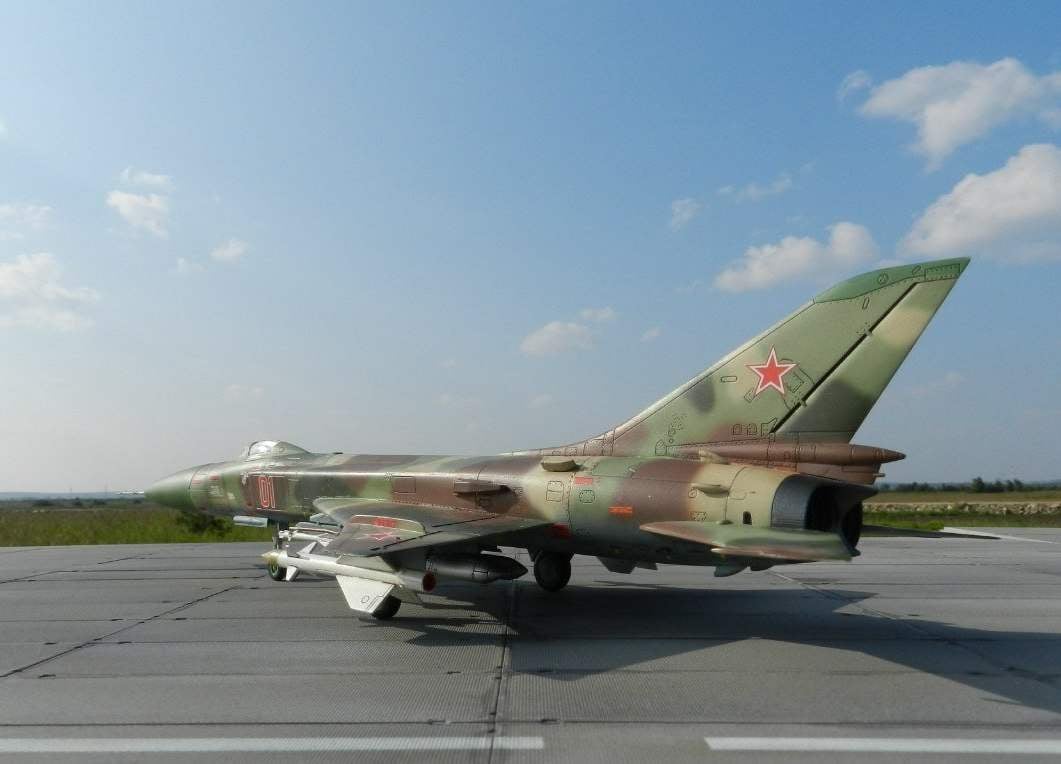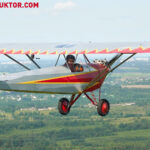 In the early 1960-ies of the Soviet armed forces required a new aviation-missile complex to combat air targets flying at altitudes from 500 to 23 000 m with a speed of from 500 to 3000 km/h. to Solve this problem was possible only through the establishment of an appropriate rocket class “air—air” and the aircraft carrier with a powerful radar gun.
In the early 1960-ies of the Soviet armed forces required a new aviation-missile complex to combat air targets flying at altitudes from 500 to 23 000 m with a speed of from 500 to 3000 km/h. to Solve this problem was possible only through the establishment of an appropriate rocket class “air—air” and the aircraft carrier with a powerful radar gun.
By the end of the 1950s, a possible scheme of the fighter-interceptor with front air intake device was almost exhausted, and her crown was the fighter aviation of air defense, su-11, equipped with guided missiles R-8M. Increase in target detection range and their escorts onboard radar is inextricably linked to its thickness and diameter of the mirror antenna, which demanded the creation of a virtually new aircraft. But at the turn of the 1960-ies there was a government ban on creation of new combat aircraft, only allowed modernization of the existing aircraft.
Then, in accordance with the February 1962 by decree of the government, under the guise of modernization began development of a new aviation complex of interception of su-11-8М1, consisting of the aircraft carrier T-58Д and two missiles K-8М1.
In the complex su-11-8М1 has provided significant advantages in combat application. Compared to the predecessor he had to hit targets in the forward hemisphere, in an extended altitude range, have improved reliability of the power plant and other aircraft systems.
The new aircraft radar “eagle-D” placed not in the Central body frontal air intake and the forward fuselage, placing the engine air intakes on its sides. The launching devices under the wing placed two missiles K-8М1, modified for firing in the forward hemisphere. The power plant includes two turbojet engines Р11Ф2-300.
In this form the first flight (aerodynamic), while intended for static strength tests, a copy of the aircraft T-58Д-1, piloted years-chick-a test pilot V. S. Ilyushin took off, on 30 may 1962. After a year of testing has passed a second instance of a prototype weapon system, which included radar “eagle-Д58”. On the first plane according to the results of flight tests has increased the area of the vertical stabilizer, the drag chute container was moved to the bottom of the keel and strengthened the chassis.
The third instance of the interceptor flew in 1963 and was transferred to NII VVS for joint state tests. Chairman of the state Commission appointed E. Y. Savitsky. Until 1964, three aircraft have completed over 250 flights, showed higher reliability T-58Д compared to su-11.
According to the results of cooperation with the customer testing of all three prototypes of the T-58Д changed the airfoil contours of the middle part of the fuselage and nose cone radar, strengthened the stabilizer, the cockpit was modified under the ejection seat COP-4, updated equipment.
The aircraft has been tested and factory in Novosibirsk began preparations for its serial production. And 470 finished products used in the su-11, the new interceptor used 379 and up to 6,000 parts made at the factory.
For the preparation of production and start of serial production aircraft in 1965, on the proposal of the Ministry of defence, the plant № 153 in Novosibirsk in 1964 he built two cars.
After completing state tests, in 1965, the complex was accepted into service under the designation su-15-98, and NATO has assigned him the code name Flagon. The first production su-15 was flown by test pilot OKB S. V. Ilyushin in 1966, and the following year, the interceptor was first shown to the General public on air parade in Domodedovo airport. Then the audience saw and its first modification—flying laboratory Т58ВД equipped with lift engines РД36-35 and is intended for testing of aircraft T-6-1 — a prototype of the future Sukhoi su-24.
The first production version of the interceptor was a training double su-15УТ without onboard radar and weapons, was created in 1968
The su-15 remained mnogoseriynoe triangular wing sweep of 60° to the front edge. To increase lift on takeoff and landing modes of flight on the wing was placed a swivel flap with a deflection angle experienced on the machines to 25°. The serial su-15 the angle of deflection of flaps on landing increased to 45° and for non-separable wrap has introduced a system of boundary layer control due to the flow on the upper surface of the flap of the air taken from the engine compressor. Starting with the 11-series su-15 have established a modified wing with an increased area of the end parts and with the kink on the front edge. This innovation improved the landing characteristics of the machine.


All-weather fighter-interceptor su-15TM:
1— PVD-7; 2—radiotransparent Radome radar “Typhoon-M”; 3 — cover operating Bay doors radar; 4 — visor lamp: 5—arm manual opening of the lantern; 6 – periscope; 7 — movable part of the cockpit; 8—inlet of cooling compartment: 9— dorsal fin; 10, rudder; 11 —radiotransparent Radome antenna-feeder system “Pion”; 12—fold compartment of the braking parachute; 13,22,32 and a 37—antenna system of state recognition; 14—main wheel KT-61/3 (880×230 mm); 15—fold niches main landing gear; 16 — fold the main wheels; 17 — thrust folds; 18 – nose wheel КН9 620×180 mm; 19— a cover of the hatch’s operational avionics; 20 fold niche nose landing gear; 21 —antenna guidance system “Lazur”; 23 -the cap of the slide sensor; 24&; 25 strut; 26 – cross-member; 27 hydrotilt cleaning (release) the main landing gear; 28 – arm suspension wheel; 29 — the cap of the pointer angle of attack; 30 — non-directional antenna of the radio compass ark-10; H 1-adjustable air intake; 33 —the flap; all-moving stabilizer 34; 35 – anti-flatter cargo; 36,92 – static electricity discharger; 38 is radio transparent panel loop antenna ARC-10; 39—antenna antenna-feeder system “Pion”; 40 — aerodynamic bulkhead; 41—aircraft launcher APU-60-1; 42 — aviation starting device PU-2-8; 43 — a beam of the wheel; 44 – slot-hinge; 45,46—the links of the folding brace; 47—a lock the retracted landing gear position; 48 — rear fold write; 49 — Gaga rear fold; 50—hydraulic cylinder control the wheels of the front landing gear; 51—absorber; 52 — axle suspension shock absorber; 53 — cylinder lift; 54 — the roller control wheels front support; 55 — the mechanism of the wheels; 56 -grounding busbar; 57—localizer aerogun ГІІ1-23L; 58—the outlet of giltedged; 59—fixing unit container; 60 back stop of the container; 61 —rear fairing of a container with cartridge box; 62-left panel of the dashboard; 63 — control scoreboard, gear, flaps and brake flaps; 64—crane chassis; 65 — control radar “Typhoon-M”; 66 console of choice kind of weapons; 67—guide-spruce artificial horizon; 68—remote control autopilot; 69— crematory sight K-10T; 70 — indicator radar; 71 —accelerometer; 72 — emergency signage; 73 — information signs; 74 — right panel of the dashboard; 75—two-point thermometer exhaust 2TVG-4; 76 — the Central panel of the dashboard; 77 – white strip; 78—aviation clock Achs-1; 79—emergency crane chassis; 80 —beam holder BDZ-57M; 81 — a guided missile of class “air-air” with a heat seeker, medium-range R-98Т; 82—a guided missile of class “air — air” with a heat seeker short range R-60; 83 is a guided missile of class “air—air” with semi-active radar homing medium-range R-98R; 84-600-liter external fuel tank; 85 — front fairing container; 86—PVD-7; 87—pull Aileron; 88—pull the flap; 89 — brake; 90 — fittings joining the nose and tail parts of the fuselage; 91— Aileron; 93—radiotransparent Radome of the antenna of the radio station R-802В; 94 — radio-panel antenna system of short-range navigation; 95 — shompolnye the junction of the panels wedge intake
The fuselage—semi-monocoque, technology was divided into bow and tail parts, and a connector between them served to replace the engines. In the bow under a conical fairing (8-series has its shape changed to ogive) was located by the radar, pressurized cabin ventilation type, air intake device and piece of equipment. In the rear were fuel tanks, engines, brake pads, parachute and other equipment.
The power plant includes two engines Р11Ф2С-300 thrust in afterburner at 6200 kgs, and on the last series—P13-300 with a thrust of 6600 kgs. Fuel volume 8060 l were placed in three fuselage, two wing and two external tanks.
Chassis tricycle with a nose wheel. Front caster with brake wheel size 660×200 mm retracted into the fuselage for flight, and basic support supplied with the brake wheel size 880×230 mm, obyavleniya in the wing a niche in the direction of the axis of the aircraft.
The equipment, except the radar, included, in particular: radio station R-802, automatic radio ark-10, the radio marker MRP-56, the instrument identification SOD-57 and SRZO-2M, guidance — “Lazur”.
The armament at first consisted of two R-8M or R-98 class “air—air” with radar and thermal GOS placed on the starting device PU-1-8. Since 1970, he added the missiles melee P-60 with a heat seeker installed on both new and were in operation aircraft. Start the R-60 was carried out on the chime, but it is, according to the testimony of pilot N. In.Mironov 636 of IAP, rest in Ukraine, “easy” was left in the Sun. R-8 could be allowed after tanning bulbs, signaling a takeover target.
After modifications of the ventral beam holders БД359ФК they were suspended containers UPK-23-250 twin-barrel cannon GSH-23L 23 mm caliber For shooting of them used a red dot sight CRPS. But to get from them even the target of MiG-17, keeping in mind the anticipation was very difficult. In addition, mount a UPK-23-250 was not tough enough.
In 1969, began public testing of an improved interceptor, the su-15T. Unlike its predecessor it was a new radar sight “Typhoon”, more powerful engines P13-300 and modified hydraulics. In addition, the aircraft established radio engineering system of short-range navigation RSBN-5C, the station warning receiver radar SPO-10 and the automatic control system SAU-58.
The project includes operation of the su-15T with groundwater and snow-covered airfields. To do this, the main landing gear was planned to replace the skis, but confined itself to test flights. Serial production su-15T innovation is not reached. To improve maneuverability on unpaved airfields, and removal of engine air intakes from the ground a nose support extended 350 mm and was equipped with two non-braking wheels size 620×180 mm. in addition, the rack is made manageable with the help of hydraulic cylinders.
During the state tests revealed serious shortcomings in the sight of the radar. For this reason the machine for service is not accepted, but serial, the plant managed to build about ten interceptors of this type. Since the new radar scope in its capabilities surpassed the “eagle-D”, built machine was sent back for revision. On arms made interceptor su-15TM with modernized radar “Typhoon-M”. In addition, the aircraft equipped with the system “Air-1”, allows you to direct the interceptor in manual, semi-automatic and automatic modes, making it easier to intercept targets flying at a speed from 500 to 2500 km/h at altitudes from 500 to 24 000 m.
Launched into production in 1970, the su-15TM subsequently repeatedly modernized and served in the air defense for more than 20 years.
The basic data of the aircraft su-15

In 1973 he created the interceptor su-15bis with engines Р25Ф-300 thrust of 7,300 kg and an automated condition monitoring system airborne equipment ask-T58. Despite the fact that the flight data of the aircraft has improved markedly, it remained in a single copy.
Last modification of the aircraft became a training su-15УМ, launched into production in 1976 and unlike its predecessor it installed the engines and wing from the su-15TM, kept the standard weapons, but due to the lack of radar used only the R-98M and R-60 with thermal homing.
Besides the already mentioned flying laboratory T-58ВД, the su-15 was used for research on in-flight refueling. The theme was called “Sakhalin”, and it involved two cars. One of them was equipped with toplivoprovoda rod and the other universal outboard unit refills (ORM). Was conducted and other studies.
Su-15 is an example of a pure interceptor. With full fuel it could fly only in the afterburning operation of the engine, but after burning half of the fuel carried out almost the entire complex aerobatics with the six-time overload.
Su-15 find the glory of “handler” of “Boeing”. The first case of forced landing of the plane “Boeing-707”, avoiding the route of flight and are deeply invaded the territory of our country, occurred on April 20, 1978, the day the Korean airliner KAL airline, flying from Paris to anchorage (Canada), was intercepted by a su-15TM of 431 IAP PVO in the Murmansk area. On established international rules signals given by captain A. I. Nosovym, the crew did not respond and increased speed, trying to reach neutral territory. Had to use weapons. Broken “the Boeing” has landed on the ice of a frozen lake near the town of Kem. Of the 108 passengers were killed and two other people. It would seem that the lesson has to go for the future, but five years later su-15TM had again engaged in battle.
This time the incident happened over the Pacific ocean. That occurred on the night of 1 September 1983, no one knows except the organizers of this provocation and Soviet participants in those events. The official version says that the Soviet pilot major G. N. Osipovich from 777 IAP, air defense fighter su-15TM stopped the flight of the airliner “Boeing-747”, all owned by the same company FECES, mistaking it for a us spy plane.
The su-15TM 18 July 1981 military pilot 166 IAP, air defense captain V. A. Kulyapin ramming attack stopped the flight of transport aircraft “Douglas” OS-6 intruder in the airspace of the Soviet Union in the South.
The serial plant in Novosibirsk handed over to the customer more than 1,400 copies of the su-15 of all modifications. The plane was removed from service shortly after the collapse of the Soviet Union, and today this car can be seen on pedestals and Museum Parking lots.
N. YAKUBOVICH



